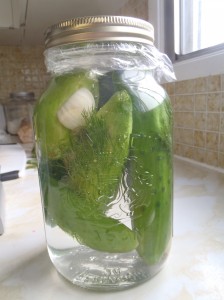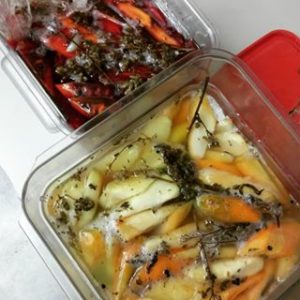 I come from a land of “refrigerator pickles”: cucumbers steeped in syrupy vinegar and spices, and stored in the fridge through the fall. There is another type of pickle called a lacto-fermented pickle. The idea of producing an acidic pickle with only brine was a revelation.
I come from a land of “refrigerator pickles”: cucumbers steeped in syrupy vinegar and spices, and stored in the fridge through the fall. There is another type of pickle called a lacto-fermented pickle. The idea of producing an acidic pickle with only brine was a revelation.
There are two ways to apply the salt and control the salt concentration: either dry salt can be added directly to the ingredient, or the ingredient can be submerged in a brine.
Direct Salting. This method is more common when the ingredient to be fermented has been sliced or chopped finely. Sauerkraut is the most familiar example in the west. For this method we typically add about 2% of the weight of the ingredient in salt. ie. for every kilo of sliced cabbage you add 20 g salt. There is definitely some wiggle room here. Once the fish sauce is added my Kim chi recipe is much higher, probably well above 3%.
With direct salting we often end up with something like a brine as liquid is leached from the ingredient. And usually we want to keep the ingredient submerged in this brine. This is why we weigh down sauerkraut. However again this isn’t always the case. Kim chi is not weighed down, and therefore is not kept submerged. Now, when sauerkraut pops above the surface it tends to mold. Kim chi does not, partly (maybe) because of the aggressive chili content, but also because the ferment happens at much colder temperatures.
A more modern technique for keeping direct-salted lacto pickles aerobic is to vac-pack the salted ingredients.
Brining. For brining we are whisking salt into water until dissolved and then submerging our ingredients in the brine. For brining the rule of thumb is 5% salt by weight of water. Note that for direct-salting the salt was weighed as a percent of the ingredient being fermented, but here it is weighed as a percent of the water in which it will be dissolved. Cover your chosen vegetables in the chilled brine (most vegetables want to float, so you’ll have to find a way to keep them submerged) and leave for a week at a cool room temperature. This is the only tricky part: the solution must stay below 23°C to prevent the proliferation of harmful bacteria. I don’t have any air-conditioning, so I wait for weeks like this, when it barely reaches 20°C outside, and then crack open the window in my “cold storage room” (also my office, where I am typing this post).

The familiar Lactobacillus bacteria consume something (lactose?) in the vegetables and create lactic acid. Lactobacillus can survive in the saline solution, while most undesirable bacteria can’t.
Once the vegetables have reached the desired balance of salty and sour, they are removed from the brine and placed in a new container. The brine is boiled to kill off any pathogens, then chilled and poured back over the vegetables. The pickles will keep indefinitely in your fridge.
That is my only misgiving about this preservation technique: the pickles are not properly canned, and so they tie up fridge space. The bulk of my cucumbers are cooked into syrupy relish, properly canned, and kept in the pantry. It’s worth saving a few vegetables for this natural pickling process. The taste is exquisite: delicate acidity and a high crunch-factor.
A Diversion on Canning Lacto-Fermented Pickles. There’s still a nagging voice in the back of my mind, a voice insisting that canning without a recipe is dangerous.
I need a book that liberates me, the home-canner, from recipes. A book that says: “This is the pH, salinity, or sugar content required to safely jar food. This is how to measure the pH of your pickles. This is the approximate pH of common household pantry items. This is how to calculate the pH of your pickling solution.” That way, instead of working from a recipe, I could start with a set of ingredients or cured products like sauerkraut and salt pork and test and adjust them to make sure they’re safe to can.
Even though I didn’t have a recipe for the canned sauerkraut, there are plenty of forums and Youtube videos from the northern US that detail the jarring of traditional home-cured sauerkraut. All the folks in these videos have friendly, trustworthy faces, so I gave it a go.
Anyways. There are several posts on Button Soup about lacto pickles. Check ’em out!
Direct-Salted Lacto Pickles
- Sauerkraut
- Kimchi
- Fermented Chili Paste
- Umeboshi-Style Lacto Plums
Brined Lact Pickles
- Kosher Dill Pickles
- Green Plums Cured like Olive